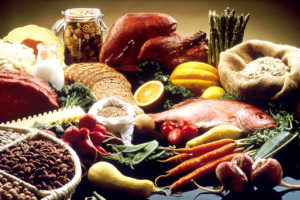In today’s world, there is an overload of stimuli coming from all angles, particularly from supernormal stimuli. Supernormal stimuli are stimuli whose characteristics are exaggerated from what is found in the natural world (1).
This term was originally coined by Niko Tinbergen, who, in his animal research, found that birds preferred to sit on a fake, really large blue egg with polka dots over the smaller blue eggs that they naturally lay. Similar-minded research was conducted with other animals as well, proving the same general ideas, in that animals prefer exaggerated characteristics in things over their natural counterparts.
Now, surely humans are smarter than birds and other animals, and thus this isn’t applicable to us right? Well, not so fast! As I said, the modern world is filled with supernormal stimuli, and many people are becoming addicted to these things, or if not addicted, still negatively affected, such as through obsessions or compulsive behaviors, because of their inability to stop their natural instincts (2).
So, what are the main forms of supernormal stimuli that are applicable to us? Mainly, junk food, social media, pornography, and internet/TV/video games.
Unnatural, Supernormal Stimuli
It doesn’t take much effort to see that all of these above things are not natural. These are all stimuli that have exaggerated characteristics for many of the things humans enjoy and find pleasure in, such as food, social connection, sex, novelty, and accomplishment.
The Role of Dopamine
And all of these exaggerations create an exceptional amount of dopamine, which leads to the desire to continue the action again and again. Many people think dopamine is the pleasure hormone, but it is more accurately termed as the “wanting hormone” because of it’s role in motivation to get a reward (3).
Dopamine is the driver of action to achieve goals, and it really isn’t all that involved in the pleasure resulting from goal achievement itself. Dopamine is released in high amounts usually when there is an anticipation of reward, and thus a desire to go out and get that reward, but not really when the actual reward hits. So, dopamine is increased when one is seeking for pleasure, essentially. This is why the desire for all of these supernormal stimuli can hijack the normal dopamine pathway, among other brain systems, leading to all of the problems.
Excess is the Problem
Now, the problem typically isn’t from these things by themselves, but rather the excessive consumption of these. You may think that it would be easy to stop yourself from engaging in these, but research says otherwise.
All of these supernormal stimuli activate reward pathways in the brain much more strongly compared to natural stimuli, and thus have the tendency to lead to addiction and/or excessive use (see references 1 and 2). Over time, these addictive-like behaviors are what ultimately lead to the real issues, both from declines in pleasure from natural rewards and from other consequences that are indirectly related, but nonetheless stem from a given stimuli. To understand this a little more closely for each of the supernormal stimuli I listed, and to figure out what to do to resolve these problems, read on below!
The Issue of Junk Food

The first major supernormal stimuli to talk about includes junk food of all sorts. In particular, the issues are sugar and fat. Both sugar and fat were highly sought after in our hunter-gatherer times because they were calorie-dense and, thus, helped provide us with energy. Fruits, tubers, and honey were some of the best foods to find in terms of sugar. And for fat, our ancestors often sought after nuts, fatty fish, and animals with significant fat on them.
Nowadays, however, food companies have overloaded foods to contain excessive amounts of sugar and fat, usually together to create an even more pleasurable response. In turn, the excess is really what’s causing the problems, not sugar or fat by themselves.
Sugar intensely activates the reward system, leading potentially to addiction (4). Plus, excessive amounts of sugar are the real problem, mainly that people continue to eat sugar long after they’ve had enough calories for the day. This is pretty easy to spot. Maybe you see it in yourself or others. So many people have a “sweet tooth”, and it is obviously very enjoyable to chow down on a big tub of ice cream or eat a handful of cookies, for example.
And it wouldn’t really be bad if you could stop at just one candy bar or a serving of chocolate; but obviously, this hardly ever happens. And for some, the pleasure leads to a full-out binge, ingesting potentially a thousand calories or more of sugar.
Fat also activates the reward system, although it has less of an addictive potential. High fat foods, in general, taste better than their lower-fat counterparts (for a healthy example, this is why fattier meats usually are more flavorful than lean cuts.) And it’s also why most fast food and other junk food is so good, in that it is loaded with unhealthy fats, whether from the frying process or just in the food itself (sometimes both!).
Further Concerns and Problems

Now, the combination of fat and sugar is the primary problem. Together, this combination lead to a number of changes in the brain, mainly in that they alter dopamine and opioid receptor functioning by creating massive, unnatural surges in these neurotransmitters, and over time this leads to addiction (5). And it is this precise combination of both fat and sugar that exists in so many products today (e.g. donuts, ice cream). It’s no wonder, then, why people have a hard time controlling their urges.
Of course, the problems don’t just end at addiction; rather, they continue into the additional effects that these food addictions or obsessions have over time. Mainly, excessive consumption of these foods over time will most likely lead to obesity and other markers of metabolic syndrome (6). Plus, eating these unhealthy foods so often may increase the risk for depression and anxiety, and will most likely damage overall mental health (7) (8). Plus, healthy foods will become less satisfying, leading to an increased risk for not eating many health foods, if any at all!
Social Media

Another very important area of human health that is being negatively affected by the modern world is social support and connection. Once again, it helps to turn back to our ancestors’ lives, in which social support and acceptance were essential for survival. Living in a community obviously made it much easier to hunt and gather food, build shelter, and simply to enjoy life, all of which promoted survival. People lived in relatively small, tight-knit communities.
The problem today, however, is that many people are being exposed to an excessive amount of social contacts, yet these are mainly in a virtual sense. With social media, people have access to hundreds of thousands, if not millions, of people, and they can see all the pictures they post and so forth.
One can now follow and be followed by a seemingly endless number of people, creating a massive surplus of social connections compared to what we are meant for. Plus, a primary feature of social media is the “like” button, regardless of what platform being used; and this button has now become a form of virtual validation and acceptance.

And together, these constant and instant notifications of likes, comments, and follows are highly exaggerated forms of social support and connection. In turn, people get increasingly attached to these social media platforms because they’re anticipating the next like, follow, and so on; dopamine of course being high all the time during this.
That’s why, when people go back into the real world, face-to-face social interactions seem less fun and pleasurable, and people don’t get as much joy from interacting with real people. Thus, to feel better, they turn back to social media to get the same rush they experienced. Over time, this can lead to an addiction. And this is supported by neuroscience research which shows that there are specific neuroplasticity changes in the brains between addicted and non-addicted social media users (9).
Communication or Eye Contact, Anyone?
This at least partially explains why many people today are looking down at their phones, even when people that they enjoy are in the same room as them! Maybe you can identify with this; for example, have you ever gone on to Facebook or Instagram to check something and then you ended up staying on there for 30 minutes or longer?
It’s sad to say, but pretty much any place where people gather or are around each other, such as city streets and waiting rooms, nearly everyone is on their phone and hardly anyone says hi or makes eye contact. It’s highly illogical, but it again shows the power of supernormal stimuli.
Over time then, social media addiction and other forms of internet addiction, paired with the usual social isolation and lack of contact in real life, can lead to many problems. Such problems include anxiety, depression, lower self-esteem, poor body image, higher physical and psychological stress, and poorer sleep quality (10) (11). Unsurprisingly, social media and internet addiction also have a strong relationship with obesity (12).
It’s also important to note that, adolescents and young adults, along with females, appear to be particularly negatively influenced by excessive social media usage, especially the former (13) (14). Yet, kids seem to be getting phones and/or exposed to social media earlier and earlier, and this only makes the problems worse. This is because the younger one starts, the harder it is to quit, and, in turn, the negative effects are usually going to be more pronounced.
Internet/TV/Video Games

This next section involves a couple of different categories, which I lumped together. This is because all of these (internet/TV/video games) supernormal stimuli relate to the idea of novelty, connection, and/or sense of accomplishment.
Internet, TV, and video games all provide humans with instant access to virtual worlds that they can explore. While surfing the internet, one can seemingly ask any possible question and get an answer; look into any topic and find out information; watch potentially millions of videos; read potentially millions of articles on endless subjects, and the list goes on and on.
With TV, there are endless genres one can choose from, and there are so many channels and stations that someone can choose exactly what they’re looking for.

And finally, for video games, these have now become so realistic that users can become entrenched into these virtual worlds, becoming enveloped in their characters to do whatever they need to do. Plus, these worlds are usually heightened with a lot of fantastical imagery, sounds, and the like, all of which attract people in to play these games.
Now, these all sound like no big deal. And in small amounts, they aren’t. But again, the problem is that through the ease of access and heightened stimuli of all of these things, the chance for addiction or obsession is extremely high.
In fact, internet and TV addiction both share very similar characteristics with substance abuse addiction, such as tolerance, withdrawal, failure to quit, and significant brain changes and impairments in brain systems, such as executive functioning (15) (16). Also, the exaggerated features of video games make these addictive as well (17).
Lack of Natural Fulfillment
Instead of learning something, one can now get an instant rush of gratification from finding and answer online. Also, access to so many videos and articles on any topic can lead someone who is just looking for one thing to eventually go on a full out YouTube or search engine binge, lasting hours or more.
Instead of socializing and communicating with others in real life, one can now feel connected through TV characters, and all of their scenes and situations. People can get so obsessed with shows that they like, that they watch for hours or more every day.
And instead of accomplishing real-life goals, one can now score the winning touchdown, kill a villain, play in a rock band, or become a legendary racecar driver, all through a virtual means. People can get so obsessed with a particular video game that the virtual reality becomes more important than actual reality.
Thus, with these things, the main problem boils down to this general idea: Instead of finding meaning, novelty, and/or achievement in real life, these vices fill the void in one’s life, simply because these things are easier to access, and they provide a heightened level of reward.
Replacing Real-Life Pleasures
And while these things feel good in the moment, the reality is that they are taking the place of real-life pleasures. When you have the internet, you’ll be less motivated to learn through experience and hardship. When you have TV, you’ll becomes less likely to socialize and create a good life in the real world. And when there are video games, you’ll be less likely to want to achieve goals, such as getting in shape, finding a date, or learning a new instrument.
And over time, all of these addictions and/or obsessions can lead to more problems. For example, internet, TV, and video game addiction all can potentially lead to or increase depression, anxiety, OCD, weight gain, sleep problems, sexual dysfunctions, and substance abuse problems (18) (19) (20).
But remember, it’s not the things by themselves, but rather the excessive use. People can still be healthy while using Internet, TV, and video games, if they are used sparingly.
Pornography
The last area I want to talk about is pornography. The internet has given rise to endless pornography videos, all of which provide a surplus of stimulation way beyond what we’re designed for. In the natural world, humans are made to see only a handful of potential partners.
And, of course, another major thing is that one actually has to talk to the person and make an effort in order to establish a romantic/passionate relationship. Now, however, with pornography, it is way too easy to “satisfy” desires. Plus, most of the videos are made in such a way that exaggerates certain features and interactions, especially in the case of women. The end result is that real-life intimate encounters are less satisfying, and there are a host of other problems that can happen as well.
With the ease of accessibility, usually free cost, and anonymous nature of porn, the fact is that more and more people are using it, and they’re usually using it excessively, and this is what can lead to an addiction (21).
Some people might argue that pornography addiction is not even a thing. And while behavioral addictions are different from substance addictions, neuroscience research definitively shows that the brain changes in pornography addiction show very similar characteristics with substance addiction (22). The supernormal stimulus of pornography definitely has an effect on the brain’s neuroplasticity as well (23).
And, as with all of the other supernormal stimuli I’ve talked about, the problems don’t end with the addiction itself, but rather continue into additional problems that stem from the addiction.
Further Problems
So, with pornography addiction, the consequences include a lack of or decreased intimacy with real partners, decreased relationship satisfaction (interpersonally and sexually), and sexual dysfunction (24) (25) (26).
Now, if you think about this, it shouldn’t be too surprising. Because if one is constantly being exposed to “picture-perfect” images and videos all day long, and also the opportunity to watch whatever they want, well then obviously real-life encounters will be less satisfying. Thus, one becomes less likely to want to engage in real-life intimacy.
To really illustrate the problems with pornography, understand that even in young men under 40, even as low as 20, there are increasing rates of erectile dysfunction (27). Yes, even in 20-somethings, the supposedly prime age.
This is a real problem. I’m not here coming from my high horse on a moral perspective or anything. I’m just here to tell you the unbiased, scientific truth; and from that perspective, pornography really should be limited, if not eliminated completely.
How to Stop This
As you can see, there are many things in today’s world that hijack our brains and lead to negative consequences. Thus, steps need to be taken to counter these negative effects.
In general, if someone is having a problem with an addiction or obsession/compulsion in any of these categories, then they have to find a way to decrease or eliminate these over time. And the way to do this is to slowly but surely fill one’s life back in with naturally feel-good things. Because the main way to end an addiction or an obsession isn’t to simply cut out something; rather, something else has to be taken up in order to “fill the void”.
Easier said than done, right? However, it can definitely be done. And while I’m not qualified to tell people exactly how to overcome addiction, I can list a few points that will almost always help.
So, the first thing is to identify the specific problem. For example, don’t just say that there is a food addiction; what specific foods are the main ones involved?
Then, figure out what are the main triggers for engaging in that behavior. For example, depressive feelings might be the trigger which leads to cravings for sweet and salty foods.
Mindfulness
Once the triggers are identified, then mindfulness has to be employed to be able to stop the triggers. Mindfulness is proven to be highly effective for overcoming all sorts of addictions, including behavioral addictions (28).

So, for this, mindfulness meditation should be practiced every day, even for as little as one minute, but ideally for five minutes to 30 minutes. Mindfulness can help to identify the urge, realize there is another option, and then finally act on that other option. Mindfulness will help one to stay in the present moment, and to be less likely to be influenced by emotion. In a way, it helps one to be stoic so as to not get pulled in by emotional desires. It also helps to ask this question: “do I really need to do/eat/watch this?” or “why am I doing this?”.
Mindfulness also helps someone determine their reason for quitting; their “why”. This is important because, without a strong enough reason, the results won’t happen. Some good examples of reasons for stopping are improved self-confidence, higher quality relationships with family and friends, enhanced self-esteem, and higher productivity. The more specific reason, the better. But without one, one is bound to keep giving in.
Replacing the Urge
And that leads me to the next point; what should one actually do then to replace the urge? The answer is simple, but also complex. It’s simple because the person should just do something natural that is related to the supernormal stimuli that’s being craved. But, it’s also complex because action actually has to be taken, day in and day out, and it won’t be easy at first.
For example, instead of turning to social media when anxious or lonely, one can call up a friend, or invite some people over, or even just talk to family members about whatever.
Another example, if someone is frequently turning to pornography, then he or she has to figure out ways to find intimate/sexual satisfaction in real life. Single individuals could try approaching some people, talk to them for a bit, and ask them out. Married people could try doing something fun or really different, whether that’s of a romantic nature or just in general.
Or, for people wanting to turn to fatty and sugary foods, they should try cooking an awesome and healthy, flavorful meal by themselves. And one can have a little indulgence too. Instead of a fast food burger, fries, and shake, how about a home-cooked steak with potatoes and a small piece of pie for dessert?
Or, what about those struggling with wanting to turn to video games or the internet in general to feel a sense of accomplishment or excitement? Well, instead, they could try a new workout, go for a walk in a different part of town, learn a new skill; the list goes on and on!
The point is that there are many natural things that everyone can do to feel good. People don’t need to turn to artificial stimuli to do the job. And over time, one can learn that the natural stimuli are just as good; in fact, they’re better!
With all of these things, it’s essential to realize that it’s all about learning how to live a happy and connected life through natural means. Because if you feel connected and happy, you won’t need to turn to anything to fill the void, because their will be no void! This is why learning how to feel good and make meaning through the natural world is one of the best things to do.
Retraining the Brain is Beyond Worth It!
It will be difficult at first, but it will get easier and easier as the brain adjusts and is rewired to respond more favorably to natural stimuli. The end results will be beyond worth it because there will come the realization that a lot of pleasure and excitement can be felt from natural things! With this comes a profound sense of accomplishment and confidence, among other positive feelings.

After retraining the brain to respond with pleasure and excitement to natural stimuli, the chances are much lower for engaging negative habits. This is simply because one won’t need those to feel good anymore! Working out, eating healthy, socializing in person, going on adventures…all of these things (and more) will lead to such a mood boost that they will be enough on their own!
A Call to Action
And this is what the world needs more of right now. Instead of engaging in artificial pleasures, we need to return to our natural ways. The supernormal stimuli do not necessarily have to be cut out completely, but they sure can be. And the more they are cut out, the less likely they are to become a problem.
The natural world has all we need to be happy and to feel good. It may not seem like it right 5now, especially for those engaging in multiple behavioral obsessions or addictions with supernormal stimuli, but this realization can be made by anyone, anywhere. And once it happens, it will be more than worth it.
The human brain is not meant for the world we live in, so everyone should make an honest effort to turn away from supernormal stimuli in favor of natural stimuli. In turn, this decision will benefit the brains, the rest of the body, and, perhaps more importantly, the relationships with all of the people and things in this world around us!
References
1. Barrett, D. (2010). Supernormal stimuli: How primal urges overran their evolutionary purpose. WW Norton & Company.
2. Goodwin, B. C., Browne, M., & Rockloff, M. (2015). Measuring preference for supernormal over natural rewards: a two-dimensional anticipatory pleasure scale. Evolutionary Psychology, 13(4), 1474704915613914. https://doi.org/10.1177/1474704915613914
3. Wise, R. A., & Robble, M. A. (2020). Dopamine and Addiction. Annual Review of Psychology, 71, 79-106. https://doi.org/10.1146/annurev-psych-010418- 103337
4. Olszewski, P. K., Wood, E. L., Klockars, A., & Levine, A. S. (2019). Excessive consumption of sugar: an insatiable drive for reward. Current Nutrition Reports, 8(2), 120-128. https://doi.org/10.1007/s13668-019-0270-5
5. Avena, N. M., Rada, P., & Hoebel, B. G. (2009). Sugar and fat bingeing have notable differences in addictive-like behavior. The Journal of nutrition, 139(3), 623–628. https://doi.org/10.3945/jn.108.097584
6. Fabiani, R., Naldini, G., & Chiavarini, M. (2019). Dietary Patterns and Metabolic Syndrome in Adult Subjects: A Systematic Review and Meta-Analysis. Nutrients, 11(9), 2056. https://doi.org/10.3390/nu11092056
7. de Sousa Fernandes, M. S., Santos, G. C. J., dos Santos, R. M., da Costa Ribeiro, I., e Silva, L. D. L. S., Cabral, A. P. D. F. A., … & Nobre, I. G. (2020). Relation of Food Addiction in Overweight/Obesity, Depression and Impulsivity: a Systematic Review and Meta-Ana lysis. Health Science Journal, 14(5), 1-14. DOI: 10.36648/1791-809X.14.4.737
8. Firth, J., Gangwisch, J. E., Borisini, A., Wootton, R. E., & Mayer, E. A. (2020). Food and mood: how do diet and nutrition affect mental wellbeing?. bmj, 369. https://doi.org/10.1136/bmj.m2382
9. He, Q., Turel, O., & Bechara, A. (2017). Brain anatomy alterations associated with Social Networking Site (SNS) addiction. Scientific Reports, 7(1), 1-8. https://doi.org/10.1038/srep45064
10. Appel, M., Marker, C., & Gnambs, T. (2020). Are Social Media Ruining Our Lives? A Review of Meta-Analytic Evidence. Review of General Psychology, 24(1), 60-74. https://doi.org/10.1177/1089268019880891
11. Sohn, S., Rees, P., Wildridge, B., Kalk, N. J., & Carter, B. (2019). Prevalence of problematic smartphone usage and associated mental health outcomes amongst children and young people: a systematic review, meta-analysis and GRADE of the evidence. BMC psychiatry, 19(1), 1-10. https://doi.org/10.1186/s12888-019-2350-x
12. Thompson, T. L. (2020). Media Use and Obesity. The International Encyclopedia of Media Psychology, 1-7.
https://doi.org/10.1002/9781119011071.iemp0104
13. Su, W., Han, X., Yu, H., Wu, Y., & Potenza, M. N. (2020). Do men become addicted to internet gaming and women to social media? A meta-analysis examining gender-related differences in specific internet addiction. Computers in Human Behavior, 113, 106480. https://doi.org/10.1016/j.chb.2020.106480
14. Keles, B., McCrae, N., & Grealish, A. (2020). A systematic review: the influence of social media on depression, anxiety and psychological distress in adolescents. International Journal of Adolescence and Youth, 25(1), 79-93. https://doi.org/10.1080/02673843.2019.1590851
15. Kurniasanti, K. S., Assandi, P., Ismail, R. I., Nasrun, M. W. S., & Wiguna, T. (2019). Internet addiction: a new addiction?. Medical Journal of Indonesia, 28(1), 82-91. https://doi.org/10.13181/mji.v28i1.2752
16. Sussman, S., & Moran, M. B. (2013). Hidden addiction: television. Journal of Behavioral Addictions, 2(3), 125-132. https://doi.org/10.1556/jba.2.2013.008
17. Astolfi, M. T. (2012). The evolutionary psychology of video games: The digital game as supernormal stimulus. Diss. New York University. https://www.semanticscholar.org/paper/THE-EVOLUTIONARY-PSYCHOLOGY-OF-VIDEO-GAMES%3A-THE-AS-Astolfi/bdd1dedc98364937a329abd66a5de186b873f4b5
18. Jorgenson, A. G., Hsiao, R. C. J., & Yen, C. F. (2016). Internet addiction and other behavioral addictions. Child and Adolescent Psychiatric Clinics, 25(3), 509-520. https://doi.org/10.1016/j.chc.2016.03.004
19. Groshek, J., Krongard, S., & Zhang, Y. (2018, July). Netflix and Ill? Emotional and Health Implications of Binge Watching Streaming TV. In Proceedings of the 9th International Conference on Social Media and Society (pp. 296-300). https://doi.org/10.1145/3217804.3217932
20. Männikkö, N., Ruotsalainen, H., Miettunen, J., Pontes, H. M., & Kääriäinen, M. (2020). Problematic gaming behaviour and health-related outcomes: A systematic review and meta-analysis. Journal of Health Psychology, 25(1), 67-81. https://doi.org/10.1177/1359105317740414
21. de Alarcón, R., de la Iglesia, J. I., Casado, N. M., & Montejo, A. L. (2019). Online porn addiction: What we know and what we don’t—A systematic review. Journal of clinical medicine, 8(1), 91. https://doi.org/10.3390/jcm8010091
22. Love, T., Laier, C., Brand, M., Hatch, L., & Hajela, R. (2015). Neuroscience of Internet pornography addiction: A review and update. Behavioral sciences, 5(3), 388-433. https://doi.org/10.3390/bs5030388
23. Hilton Jr, D. L. (2013). Pornography addiction–a supranormal stimulus considered in the context of neuroplasticity. Socioaffective Neuroscience & Psychology, 3(1), 20767. https://doi.org/10.3402/snp.v3i0.20767
24. Hesse, C., & Floyd, K. (2019). Affection substitution: The effect of pornography consumption on close relationships. Journal of Social and Personal Relationships, 36(11-12), 3887-3907. https://doi.org/10.1177/0265407519841719
25. Wright, P. J., Tokunaga, R. S., Kraus, A., & Klann, E. (2017). Pornography consumption and satisfaction: A meta-analysis. Human Communication Research, 43(3), 315-343. https://doi.org/10.1111/hcre.12108
26. Park, B. Y., Wilson, G., Berger, J., Christman, M., Reina, B., Bishop, F., … & Doan, A. P. (2016). Is Internet pornography causing sexual dysfunctions? A review with clinical reports. Behavioral Sciences, 6(3), 17. https://doi.org/10.3390/bs6030017
27. Dwulit, A. D., & Rzymski, P. (2019). The potential associations of pornography use with sexual dysfunctions: an integrative literature review of observational studies. Journal of clinical medicine, 8(7), 914. https://doi.org/10.3390/jcm8070914
28. Sancho, M., De Gracia, M., Rodriguez, R. C., Mallorquí-Bagué, N., Sánchez-González, J., Trujols, J., … & Menchón, J. M. (2018). Mindfulness-based interventions for the treatment of substance and behavioral addictions: a systematic review. Frontiers in psychiatry, 9, 95. https://doi.org/10.3389/fpsyt.2018.00095




